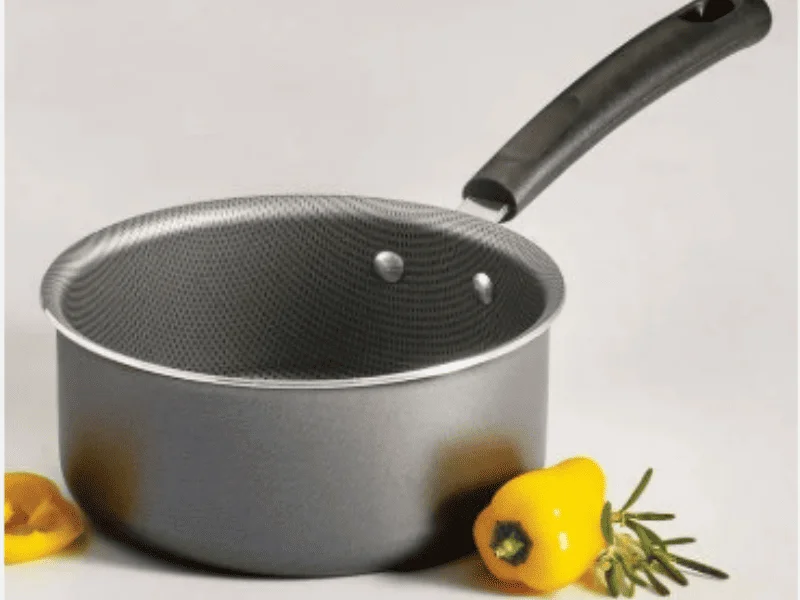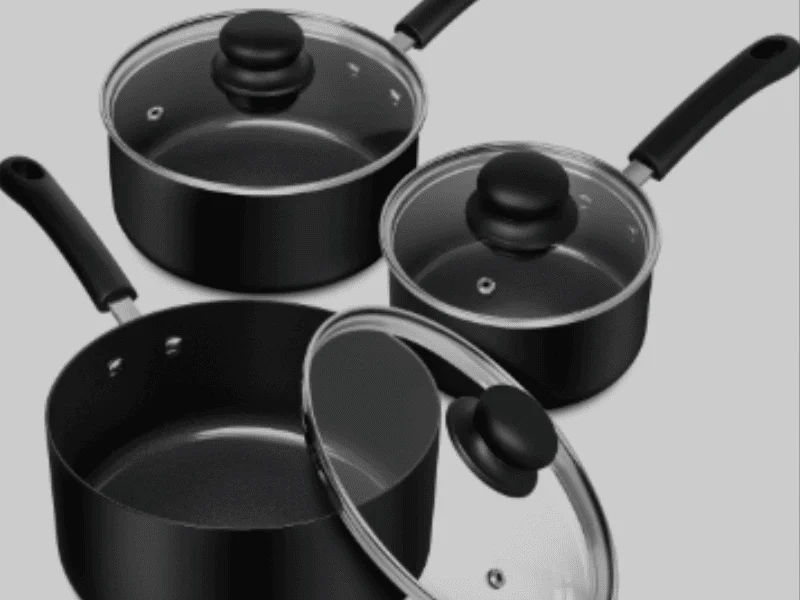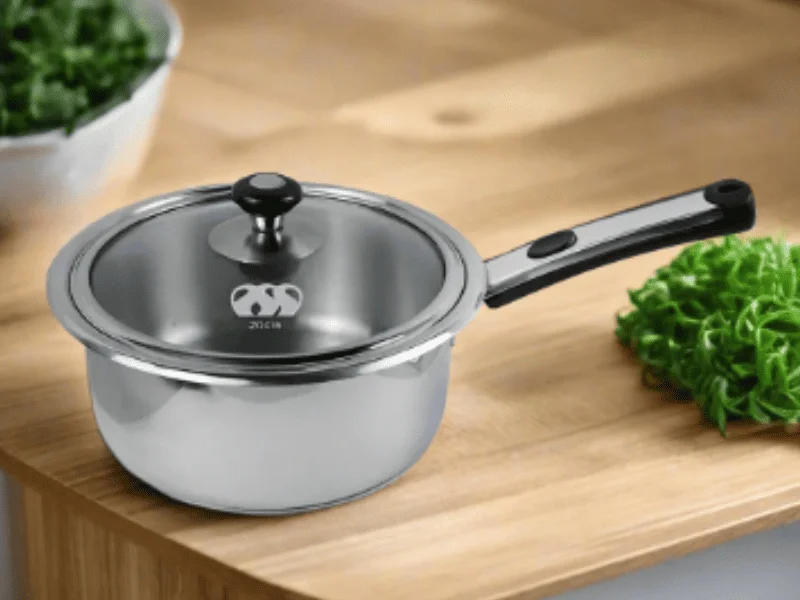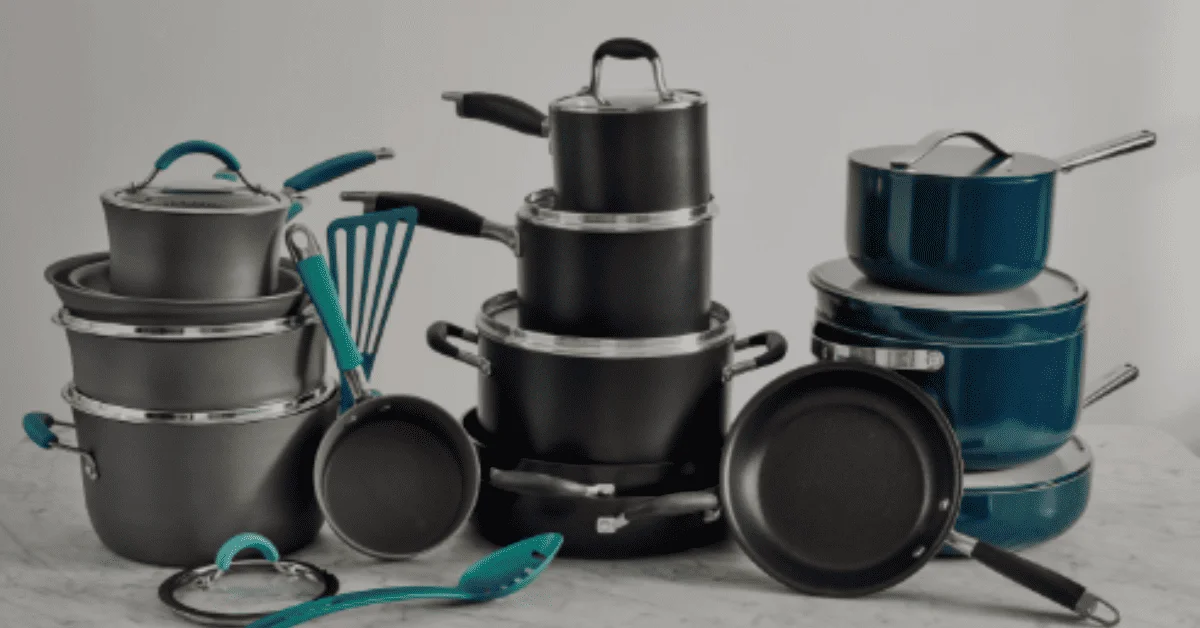The sauce pan is the silent hero of your kitchen, whether you are making a rich homemade sauce, boiling pasta, or simmering a soup. We will go over the advantages of using a saucepan pan, how to buy the finest one, and why this basic yet adaptable pan ought to be in every home cook’s toolkit in this extensive guide.
Often, when we consider necessary kitchen appliances, we think of pressure cookers, frying pans, or even high-end blenders. One underappreciated component of cookware, though, silently manages a range of chores: the saucepan pan.
What Is a Sauce Pan?
Let us first define a sauce pan before we explore the reasons you might require one. All told, it’s a long handle, flat bottom, deep, spherical cooking pot with towering sides. Since most sauce pans have lids, they are ideal for cooking liquids that is, for boiling, simmering, or sauce making.
One sauce pan distinguishes itself from other cookware in its design. Its high sides let more liquid to be contained, which makes it perfect for boiling or simmering; the long handle guarantees you can move it comfortably and safely.
Although skillets and fried pans have their uses in the kitchen, the sauce pan is really a multitasker, flexible enough to manage a great range of foods. It’s the ideal accompaniment for everything from rice and pasta to sauces and soups.

Why Every Kitchen Needs a Sauce Pan
Now that we know what a saucepan pan is, let’s take a look at why it should be a staple in your kitchen. Here are several reasons why this cookware is so important:
Versatility
The adaptability of a saucepan pan is the most clear indication you need one. You can apply it in a rather range of culinary methods. Have to create some sauce for your pasta? That can be handled in the saucepan pan. Either rice or potatoes should be boiled. This pan covers it. You may even reheat fridge soups or sauces without worrying about burning or leaking.
A saucepan pan’s main benefit is that it can be utilized across many kinds of dishes. The saucepan pan is your go-to for nearly every liquid-based recipe, whether you’re making a fast midweek supper or something more complex.
Perfect for Cooking with Liquids
A saucepan pan works well for cooking liquids. You might boil pasta, simmer a thick stew, or create a light custard with it. Its high sides reduce the possibility of spillage and help to keep the drink within. This makes it perfect for soups and sauces requiring long simmering times or low heat cooking over.
Another reason to choose a pot for liquid-based recipes is its form makes cooking meals uniformly simpler. The high sides help heat to distribute more easily, therefore your food cooks uniformly instead of scorching or adhering to the sides.
Beginner-Friendly
For those just starting out in cooking, a saucepan pan is quite easy to use. Regarding more sophisticated cooking techniques requiring particular tools, a pot is simple. Simply put the ingredients you want to use in it, turn on the heat, and stir it now and then.
Unlike some other pans, the saucepan pan is simpler to operate and requires knowledge of spatula flipping of food. Messing around is not easy. A pot pan is absolutely something you should get for people who just start cooking.
Even Heat Distribution
A pot is ability to mete out heat around is one of its most critical qualities. Good saucepans are constructed such that the bottom and sides equally receive heat. Your food so cooks at the same temperature all through.
This is an excellent approach for soups and sauces that require the heat to be distributed uniformly so they avoid burning. Using a pot can help you to guarantee that your supper is always flawless and ready. This is true whether your tomato sauce is basic or more sophisticated béchamel calls for.
Space-Saving and Energy-Efficient
Your kitchen is small or you have inadequate cupboard space, a saucepan pan is great. Its tiny footprint makes it fit most kitchens, and its versatility means you won’t need numerous pans restricting your cupboards. Actually, in performance, a good saucepan can replace several other cooking equipment.
Many modern saucepans also offer equal heat distribution, which accelerates food cooking and hence reduces cooking time and energy consumption. This is beneficial if you are tiresome to save energy or minimize cooking expenses.
How to Choose the Right Sauce Pan for Your Needs
Many cooking pans are available, which could make it hard to pick the right one. Remember these key ideas while selecting a pot:
Material
The material of the saucepan affects both its cooking performance and longevity. Here are the most common options:
- Stainless Steel: Your food won’t taste different because it’s strong, easy to clean, non-reactive that is. One often used choice for saucepans is stainless steel. It also lasts many years and looks great in strong heat.
- Non-stick: Cooking delicate dishes like sauces is ideal for non-stick saucepans since they help avoid sticking and ease cleaning up. Non-stick pans do, however, require more care since they may fade with time
- Aluminum: Usually light-weight and quick heating, aluminum saucepans. You should choose a premium covered aluminum pan, though, as aluminum pans react with acidic foods like tomatoes.
- Copper: Perfect for precision cooking, copper saucepans are superb in heat conduction. Still, they can be more costly and need more maintenance. For more details please visit this site
Size and Capacity
The kind of cooking you perform most of the time will decide the size pot you require. Smaller houses or one-person cooking would benefit from a 1.5-to 2.5-liter pot. Those with larger families or lots of visitors over perhaps wish for a 3-liter or larger pot.
Handle and Lid
Safety mostly relies on a heat-resistant handle, especially when boiling liquid is placed into a saucepan. Make sure the handle feels good in your hand and is strong enough to carry the weight of the pan fully.
Another vital thought for a saucepan is a close-fitting cover. Cooking anything like rice or stews depends on heat and moisture being trapped by a proper cover. Another useful glass lid lets you observe your cooking without lifting the lid and allowing the heat to escape.

How to Maintain Your Sauce Pan for Long-lasting Performance
A saucepan pan is an investment in your kitchen, so proper care is important to ensure it performs well for years to come. Here are some maintenance tips:
- Stainless Steel: Hand wash stainless steel pans for enhanced lifetime even though they are dishwasher safe. To get rid of tough stains, use baking soda and water.
- Non-stick: To stop scratches on non-stick surfaces, steer clear of metal utensils.
- Copper: To keep its brilliance, copper calls for particular attention. Regular polish and clean with a copper cleaner specifically.
- Glass Lids: Watch carefully to avoid damaging glass lids. With non-abrasive towels, gently clean them.
Real-Life Uses for Your Sauce Pan
Once you’ve got your saucepan, you’ll find yourself reaching for it every day. Here are some of the most common uses for your new kitchen hero:
- Boiling Pasta: Without concern about the water overflowing, the ideal size for a small to medium batch of pasta is this one.
- Cooking Rice: Rice will cook evenly in a skillet without spilling given enough space.
- Making Sauces and Gravies: Perfect simmering in a saucepan lets you create either a basic tomato sauce or a complex beurre blanc
Keeping the components buried in liquid, create a pot of your preferred soup or stew in your saucepan. - Reheating Leftovers: If last night’s supper leftovers abound, the sauce pan is perfect for gently reheating without drying out the food.
Top Sauce Pan Picks for 2025
If you’re looking to buy a new saucepan pan, here are some great options to consider:
Cuisinart Stainless Steel Saucepan (2-Quart)
- Great build, even heating
- Dishwasher safe
- Glass lid included
T-fal Nonstick Sauce Pan with Lid (3-Quart)
- Easy to clean
- Perfect for beginners
- Comfortable grip handle
All-Clad Copper Core Sauce Pan (Premium Pick)
- Professional quality
- Excellent heat control
- Heavy-duty construction

Conclusion:
That’s it! The basic yet essential sauce pan serves purposes beyond merely being a culinary utensil. You may prepare anything from basic spaghetti to complex sauces with this instrument. It is simple to use, adaptable, and consumes minimal space.
You need a pot pan regardless of your cooking knowledge. Immediately add this crucial piece of cookware to your set. Using it will change you and never cook the same way again!
Call-to-Action:
If you’re ready to elevate your cooking game, check out our recommended saucepan pans above and get one that fits your cooking style and budget. You’ll be amazed at how much easier your kitchen life becomes!
